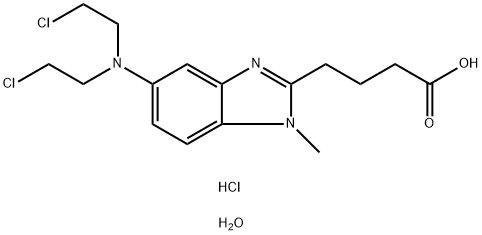Commercial bendamustine hydrochloride monohydrate crystallizes in the monoclinic space group P21/c (14), with a = 4.71348(4) Å, b = 47.5325(3) Å, c = 8.97458 (5) Å, β = 96.6515(8)°, V = 1997.161(23) Å3, and Z = 4[1].
Bendamustine hydrochloride monohydrate (marketed as Treanda?) is a nitrogen mustard purine analog alkylator used to treat chronic lymphocytic leukemia (CLL) and non-Hodgkin lymphomas. Bendamustine is a nitrogen mustard drug used to treat chronic lymphocytic leukemia (CLL) and indolent B-cell non-Hodgkin lymphoma (NHL). Bendamustine is a bifunctional mechlorethamine derivative capable of forming electrophilic alkyl groups that covalently bond to other molecules. Through this function as an alkylating agent, bendamustine causes intra- and inter-strand crosslinks between DNA bases, resulting in cell death. It is active against both active and quiescent cells, although the exact mechanism of action is unknown.
Bendamustine is a therapeutic agent employed in treating lymphomas and chronic lymphocytic leukemia. It may be useful in central nervous system (CNS) malignancies treatment regimen due to its penetration capacity into brain tissue. Bendamustine is a promising candidate for non-Hodgkin lymphoma and Hodgkin lymphoma therapies.', 'Bendamustine hydrochloride is a DNA-alkylator with a distinct pattern of activity. Bendamustine activates DNA-damage stress response and apoptosis; inhibits mitotic checkpoints; and induces mitotic catastrophe.
[1] J. Kaduk. “Powder X-ray diffraction of bendamustine hydrochloride monohydrate, C16H22Cl2N3O2Cl·H2O.” Powder Diffraction 34 1 (2018): 74–75.
